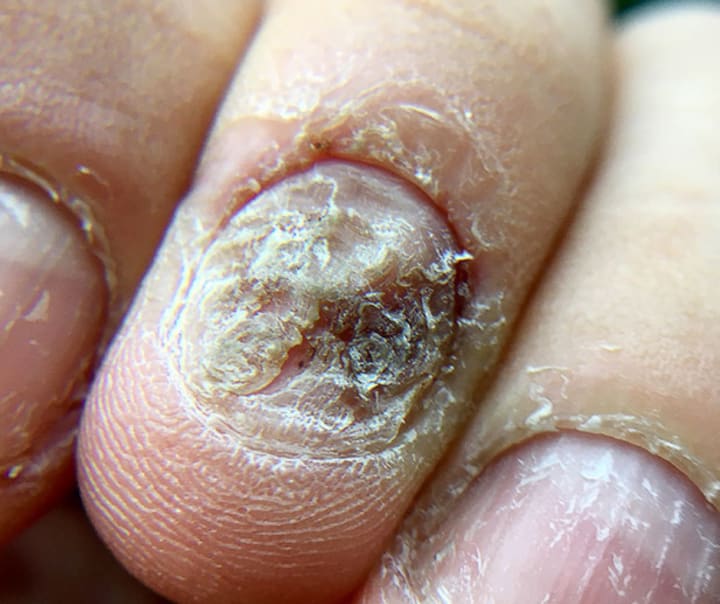"Don't Let Fungal Nail Infections and Diabetes Bring You Down - Here's What You Need to Know!"
"Combatting Fungal Nail Infections with Diabetes: Expert Tips and Strategies"

Fungal nail infections, also known as onychomycosis, are a common condition that can affect people of all ages and backgrounds. However, for those with diabetes, fungal nail infections can pose a more serious health risk. Diabetes can weaken the immune system and affect circulation to the feet, which can make it harder for the body to fight off infections and heal wounds. This means that fungal nail infections in people with diabetes may take longer to heal and can potentially lead to complications such as foot ulcers or even amputations. It's important for people with diabetes to be aware of the risks associated with fungal nail infections and take steps to prevent and treat them. In this article, we'll explore the connection between fungal nail infections and diabetes, as well as natural remedies and other treatments to help manage the condition.

Fungal nail infections, or onychomycosis, are a common condition that can affect people of all ages and backgrounds. However, for those with diabetes, fungal nail infections can pose a more serious health risk. Diabetes can weaken the immune system and affect circulation to the feet, which can make it harder for the body to fight off infections and heal wounds. This means that fungal nail infections in people with diabetes may take longer to heal and can potentially lead to complications such as foot ulcers or even amputations.
Causes and Symptoms of Fungal Nail Infections in Diabetics
Fungal nail infections are caused by various types of fungi, including dermatophytes, yeasts, and molds. These fungi thrive in warm, moist environments, such as sweaty socks and shoes. People with diabetes are at an increased risk of developing fungal nail infections due to several factors, including high blood sugar levels, weakened immune systems, and poor circulation to the feet.
The symptoms of a fungal nail infection can vary, but may include:
- Thickened, discolored nails
- Brittle, crumbly or ragged nails
- Nails that are distorted in shape or separated from the nail bed
- A foul odor coming from the infected nail
- Pain or discomfort in the affected nail or surrounding area
Prevention and Treatment of Fungal Nail Infections in Diabetics
Preventing fungal nail infections is key for people with diabetes. Some tips for preventing infections include:
- Keeping feet clean and dry
- Wearing shoes and socks that allow for ventilation and breathing room
- Avoiding walking barefoot in public areas like locker rooms or swimming pools
- Avoiding sharing nail clippers or other personal care items with others
- Treating any athlete's foot infections promptly
If a fungal nail infection does develop, there are several treatment options available. Over-the-counter topical antifungal creams, ointments or nail polishes can be effective for mild infections. For more severe or persistent infections, prescription antifungal medications may be necessary. In some cases, the affected nail may need to be removed to allow for proper treatment and healing.
Natural remedies can also be helpful for managing fungal nail infections in people with diabetes. Some natural remedies that have been shown to be effective include tea tree oil, vinegar, and baking soda. These remedies can be applied topically to the affected nail or used in foot soaks or baths.
Managing Fungal Nail Infections in Diabetics
Managing fungal nail infections in people with diabetes requires a comprehensive approach that addresses both the infection itself and any underlying diabetes-related complications. It's important to work closely with a healthcare provider to develop a treatment plan that is tailored to your specific needs and medical history.
In addition to traditional medical treatments and natural remedies, there are several lifestyle changes that can help manage fungal nail infections in people with diabetes. Some tips for managing infections include:
- Maintaining good blood sugar control
- Eating a healthy diet that is rich in vitamins and nutrients
- Exercising regularly to improve circulation and overall health
- Quitting smoking, which can worsen circulation and increase the risk of infections
Conclusion
Fungal nail infections can be a serious health risk for people with diabetes. However, with proper prevention and treatment, it is possible to manage these infections and reduce the risk of complications. By maintaining good foot hygiene, using effective treatment options, and working closely with a healthcare provider, people with diabetes can take control of their health and reduce the impact of fungal nail infections.
FAQ (Frequently Asked Questions)
Q: Why are people with diabetes more susceptible to fungal nail infections?
A: People with diabetes are more susceptible to fungal nail infections due to several factors, including high blood sugar levels, weakened immune systems, and poor circulation to the feet.
Q: What are the symptoms of a fungal nail infection in someone with diabetes?
A: The symptoms of a fungal nail infection in someone with diabetes can include thickened, discolored nails, brittle, crumbly or ragged nails, nails that are distorted in shape or separated from the nail bed, a foul odor coming from the infected nail, and pain or discomfort in the affected nail or surrounding area.
Q: How can fungal nail infections be prevented in people with diabetes?
A: Preventing fungal nail infections is key for people with diabetes. Some tips for preventing infections include keeping feet clean and dry, wearing shoes and socks that allow for ventilation and breathing room, avoiding walking barefoot in public areas like locker rooms or swimming pools, avoiding sharing nail clippers or other personal care items with others, and treating any athlete's foot infections promptly.
Q: What are the treatment options for fungal nail infections in people with diabetes?
A: Treatment options for fungal nail infections in people with diabetes can include over-the-counter topical antifungal creams, ointments or nail polishes for mild infections, prescription antifungal medications for more severe or persistent infections, and in some cases, removing the affected nail to allow for proper treatment and healing.
Q: Are there any natural remedies that can be used to treat fungal nail infections in people with diabetes?
A: Yes, some natural remedies that have been shown to be effective for managing fungal nail infections in people with diabetes include tea tree oil, vinegar, and baking soda. These remedies can be applied topically to the affected nail or used in foot soaks or baths.
Q: What lifestyle changes can help manage fungal nail infections in people with diabetes?
A: Some lifestyle changes that can help manage fungal nail infections in people with diabetes include maintaining good blood sugar control, eating a healthy diet that is rich in vitamins and nutrients, exercising regularly to improve circulation and overall health, and quitting smoking, which can worsen circulation and increase the risk of infections.
About the Creator
Consumer Chronicles
Consumer Chronicles: Your go-to source for honest and informative product reviews from real-life consumers. Get insights before you buy! #productreviews






Comments
There are no comments for this story
Be the first to respond and start the conversation.